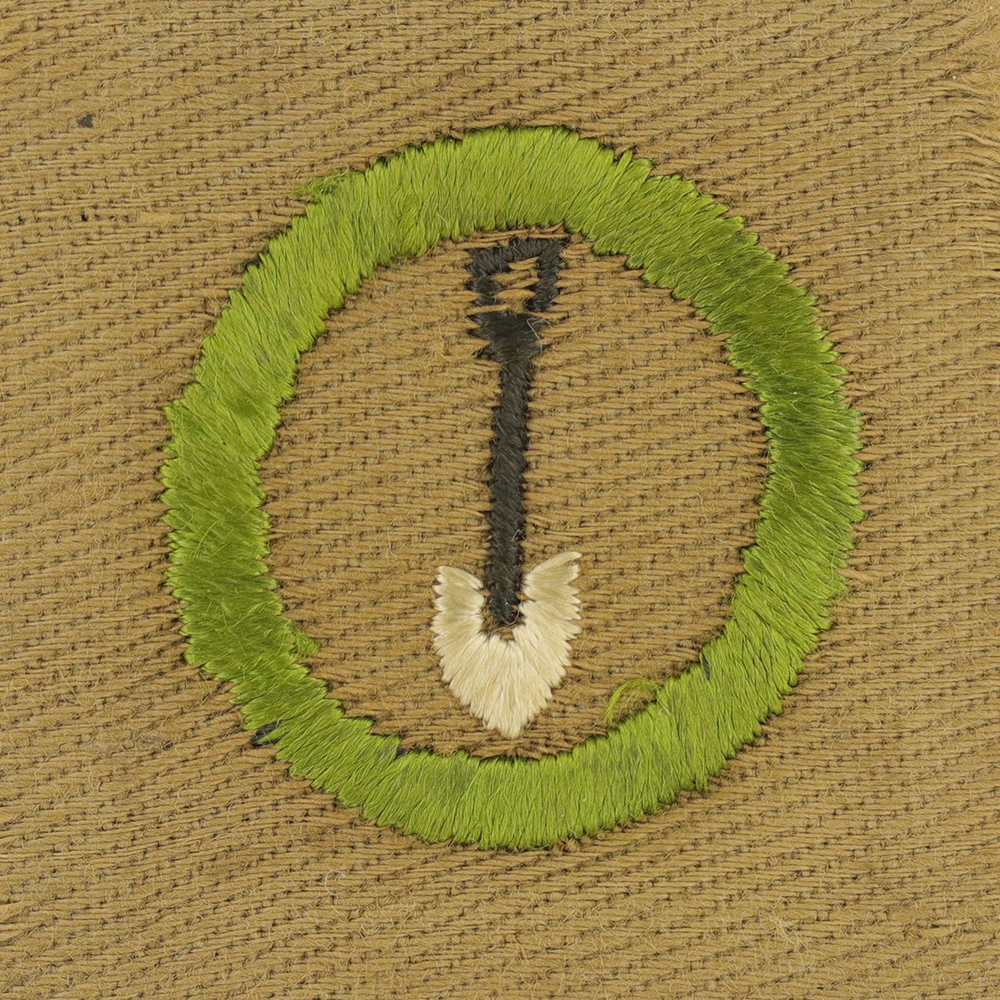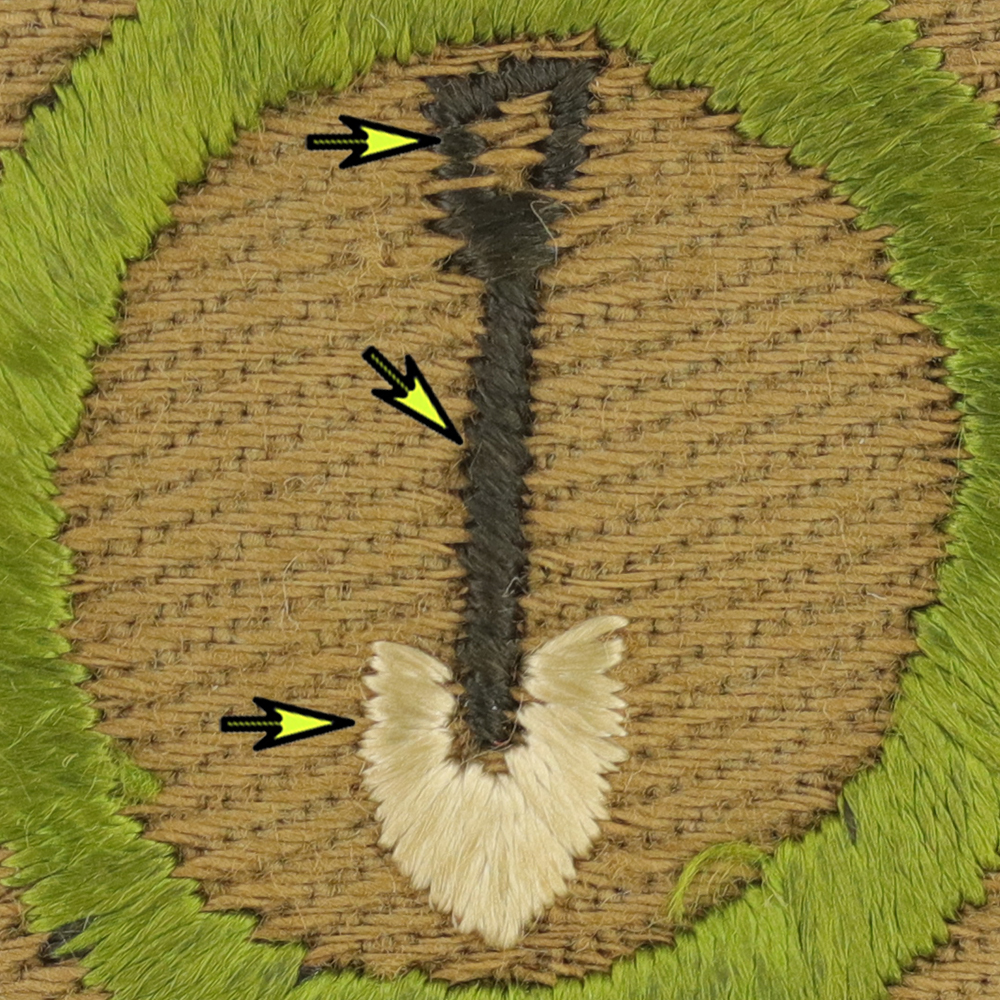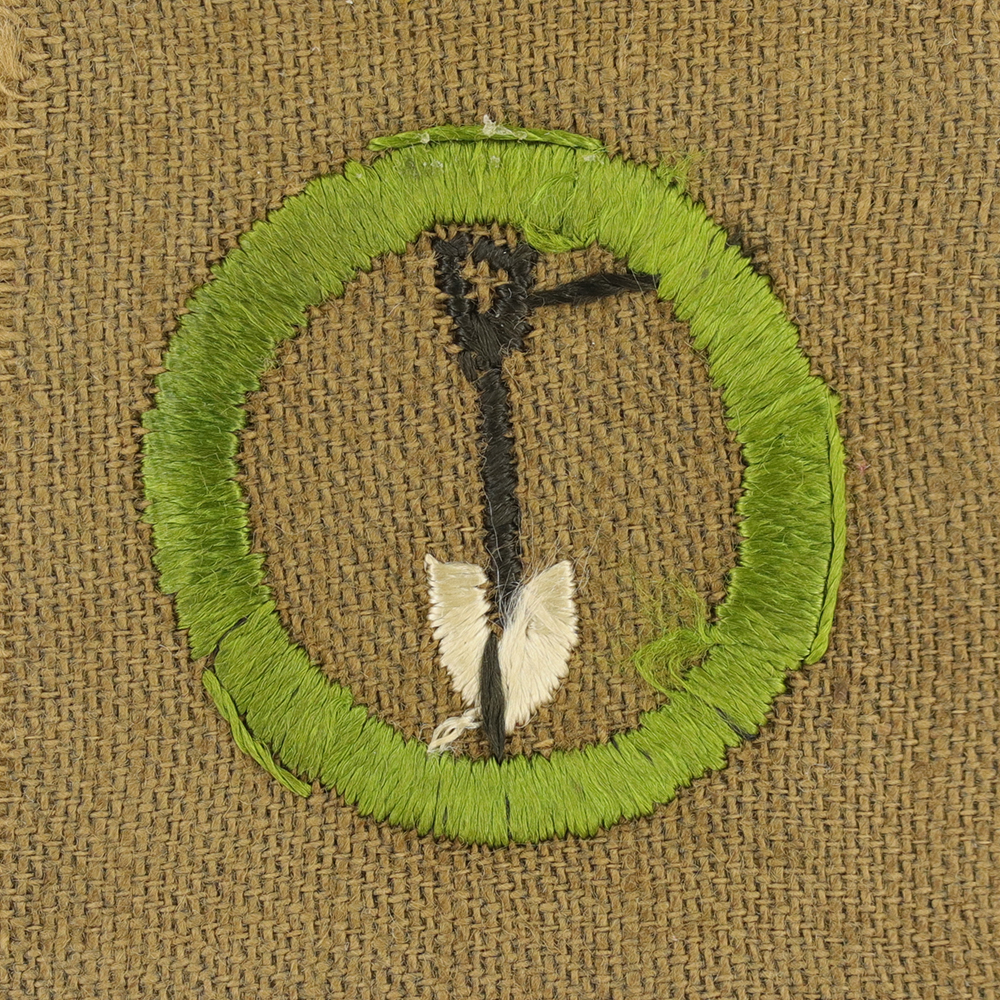
Fig. 1: Mining-AD-Front

Fig. 2: Mining-AD-Magnified

Fig. 3: Mining-AD-Reverse
Item Name: Mining 1933
Item ID: Mining-AD
Collector Rating: 1
Additional Info:
- Fig. 1
- Cloth: Depression tan right twill
- Embroidery: Silk continuous
- Fig. 2:
- Design: Spade blade, handle into top of blade, hole in handle end
- Fig. 3:
- Back: Black imprint
Pamphlets Used to Earn this Badge
Requirements October 1914 until March 1927
To obtain a merit badge for Mining, a scout must:
1. Identify and describe twenty-five minerals.
2. Define vein, placer, lode, stratum, dip, strike, joint, fault; and identify ten different kinds of rocks.
3. State what metals are mined from placer. State in what general respects placer mining differs from lode or vein mining.
4. Describe how mines are ventilated. Give the conditions that differentiate coal mining from metal mining.
5. Describe systems for mine ventilation, safety devices, and rescue methods as taught by the American Red Cross Society.
Requirements March 1927 until November 1927
1.-Make a collection of twenty-five minerals, labelled and prepared for display.
2.-Explain what he means by a mineral, and what tests he applies in identifying a new specimen when it is given him.
3.-Describe the following:--noting under the ores what metal each contains, and recording where and how he obtained his specimens.
Ores--12 specimens in all: Limonite or brown iron ore. Hematite, either red or specular and magnetite. Copper ores, pyrites or iron sulphide or fools' gold. Galena--lead ores; zinc ores.
Rock makers--Produce and label 3 of each:--quartz, calcite, feldspar, mica, hornblende.
4.-Rock formations:
(Igneous):--Tell what granite is, basalt:
(Sedimentary):--Sandstone, conglomerate, limestone.
(Metamorphic):--Slate, marble, gneiss.
5.-Explain the following: What is a dike? What is a bed, a stratum? What is an anticlinal fold: a synclinal fold? What is a fault; how many common kinds?
6.-Explain the following: What is a placer deposit? What metals do we obtain from placers? How are they mined? Why are these particular minerals found in placers?
7.-Explain how rock or ore is mined on surface.
8.-Explain how and when we mine coal by stripping. How and when by underground working; an entry, a chamber, an aircourse, "robbing pillars"; the room and pillar system of coal mining; the "Long-wall system of mining."
9.-Tell what other ores are mined in beds and how these are mined.
10.-Explain how we locate petroleum and natural-gas pools, and how we obtain the oil and gas.
11.-Tell what we mean by "milling," "ore-dressing" or "concentration," and why we practice it; give an example.
12.-Make a test of three kinds of ore and three rocks.
13.-Tell the principal machinery used in a quarry or in a mine.
14.-Give five rules of safety in and around mines.
15.-Make up two lists of all the mineral substances that are used in and around his home. In the first list, he must put those that are permanently useful, like silverware, and in the second list, those that are destroyed in use, like coal.
Requirements January 1928 until January 1930
1. Make a collection of twenty-five minerals, labelled and prepared for display.
2. Explain what he means by a mineral. What tests he applies in identifying a new specimen when it is given him.
3. Describe the following:--noting under the ores what metal each contains, and recording where and how he obtained his specimen.
Ores--12 specimens in all: Limonite or brown iron ore. Hematite either red or specular, and magnetite. Copper ores, pyrites or iron sulphide or fools' gold. Galena--lead ores; zinc ores.
Rock makers--Produce and label, 3 of each:--quartz, calcite, feldspar, mica, hornblende.
4. Rock formations:
(Igneous): Tell what granite is, basalt:
(Sedimentary): Sandstone, conglomerate, limestone:
(Metamorphic): Slate, marble, gneiss.
5. Explain the following: What is a dike? What is a bed, a stratum? What is an anticlinal fold: a synclinal fold? What is a fault; how many common kinds?
6. Explain the following: What is a placer deposit? What metals do we obtain from placers? How are they mined? Why are these particular minerals found in placers?
7. Explain how rock or ore is mined on surface.
8. Explain how and when we mine coal by stripping; how and when by underground working; an entry, a chamber, an aircourse; "robbing pillars"; the room and pillar system of coal mining; the "Long-wall system of mining."
9. Tell what other ores are mined in beds and how these are mined.
10. Explain how we locate petroleum and natural gas pools, and how we obtain the oil and gas.
11. Tell what we mean by "milling," "ore-dressing" or "concentration," and why we practice it. Give an example.
12. Make a test of three kinds of ore and three rocks.
13. Tell the principal machinery used in a quarry or in a mine.
14. Give five rules of safety in and around mines.
15. Make up two lists of all the mineral substances that are used in and around his home. In the first list, he must put those that are permanently useful, like silverware, and in the second list, those that are destroyed in use, like coal.
Requirements January 1930 until September 7, 1937, between September 7, 1937 and January 1, 1938 these requirements were optional.
1. Make a collection of twenty-five minerals, labelled and prepared for display.
2. Explain what he means by a mineral. What tests he applies in identifying a new specimen when it is given him.
3. Describe the following: noting under the ores what metal each contains, and recording where and how he obtained his specimen.
Ores--12 specimens in all: Limonite or brown iron ore, Hematite either red or specular, and magnetite. Copper ores, pyrites or iron sulphide or fools' gold. Galena--lead ores, zinc ores.
Rock makers--Produce and label 3 of each:--quartz, calcite, feldspar, mica, hornblende.
4. Rock formations: Tell what the following are:
(Igneous): Granite, basalt:
(Sedimentary): Sandstone, conglomerate, limestone:
(Metamorphic): Slate, marble, gneiss.
5. Explain the following: What is a dike? What is a bed, a stratum? What is an anticlinal fold: a synclinal fold? What is a fault, how many common kinds?
6. Explain the following: What is a placer deposit? What metals do we obtain from placers? How are they mined? Why are these particular minerals found in placers?
7. Explain how rock or ore is mined on surface.
8. Explain how and when we mine coal by stripping; how and when by underground working; what is meant by an entry, a chamber, an air-course; "robbing pillars"; the room and pillar system of coal mining; the "Long-wall system of mining."
9. Tell what other ores are mined in beds and how these are mined.
10. Explain how we locate petroleum and natural gas pools, and how we obtain the oil and gas.
11. Tell what we mean by "milling," "ore-dressing" or "concentration," and why we practice it. Give an example.
12. Make a test of three kinds of ore and three rocks.
13. Describe the principal machinery used in a quarry or in a mine.
14. Give five rules of safety in and around mines.
15. Make up two lists of all the mineral substances that are used in and around his home. In the first list, he must put those that are permanently useful, like silverware, and in the second list, those that are destroyed in use, like coal

